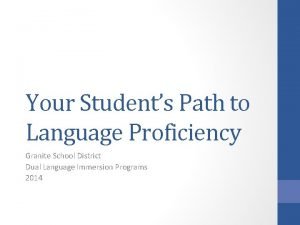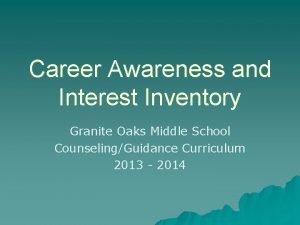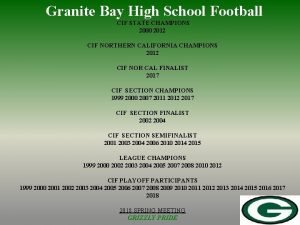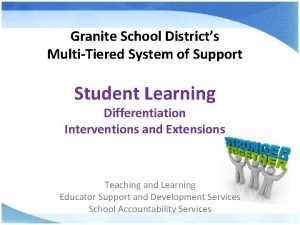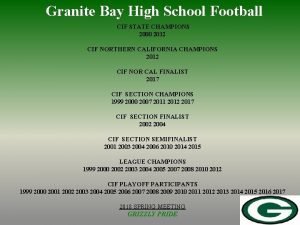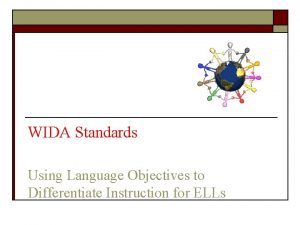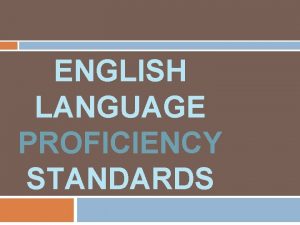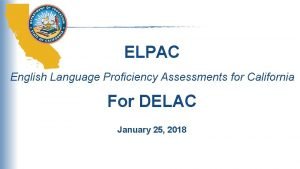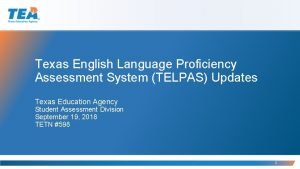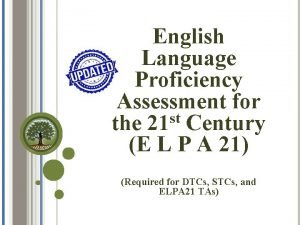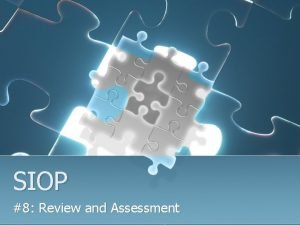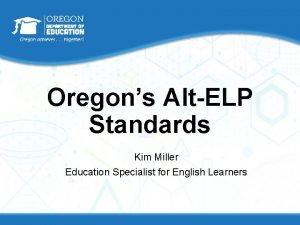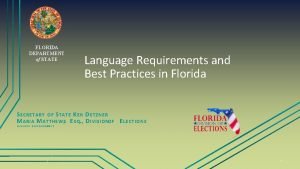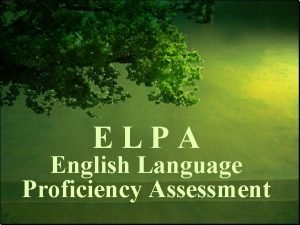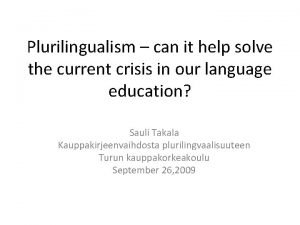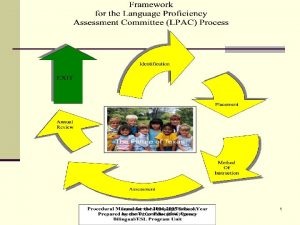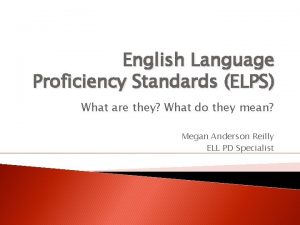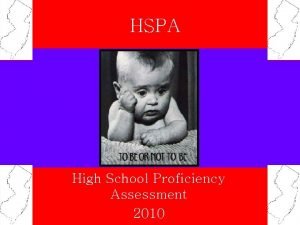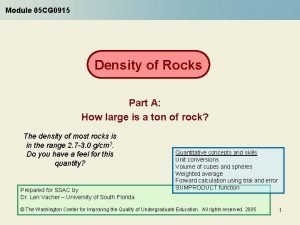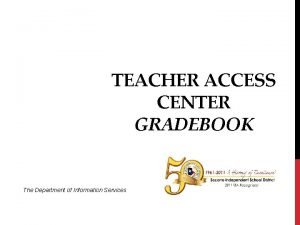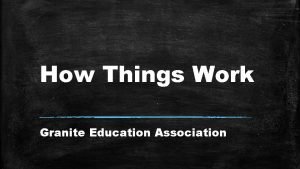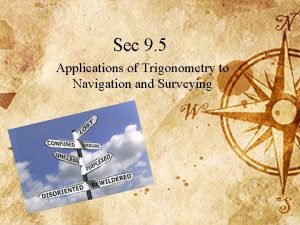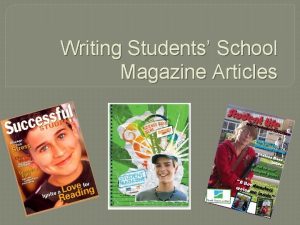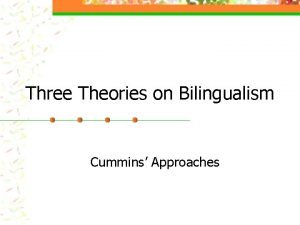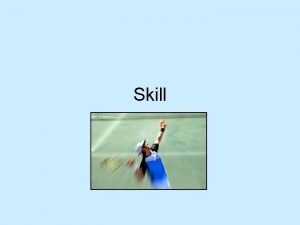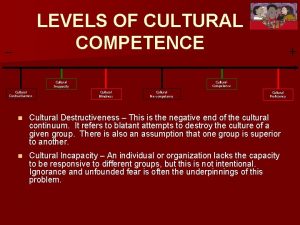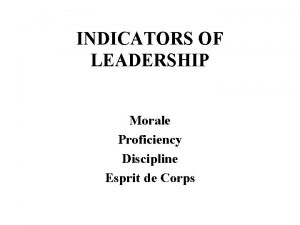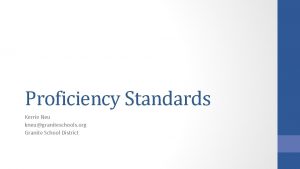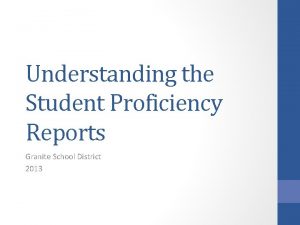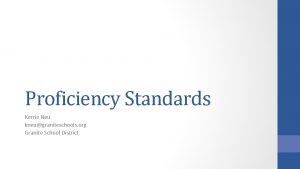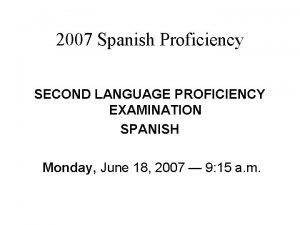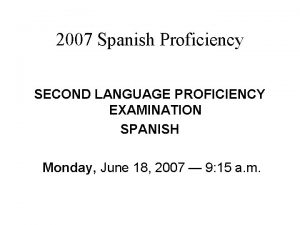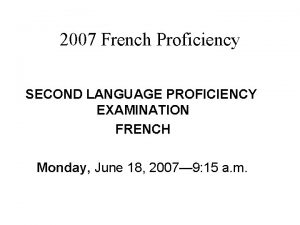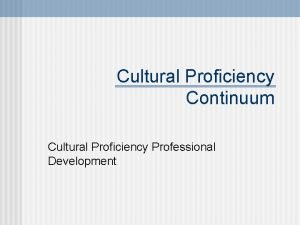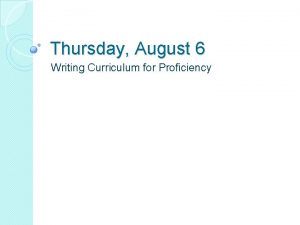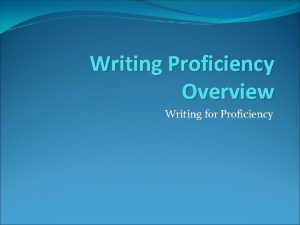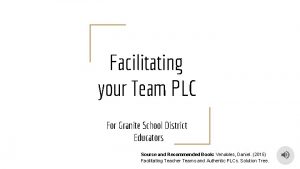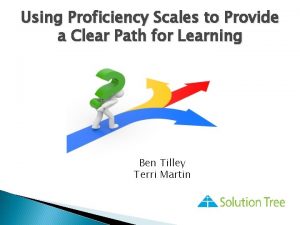Your Students Path to Language Proficiency Granite School


























































- Slides: 58

Your Student’s Path to Language Proficiency Granite School District Dual Language Immersion Programs 2014

http: //scsworldlanguages. weebly. com/proficiency-tools. html

What is language proficiency? • It’s not about passing a test or getting the right answer. • It’s about what students can DO with the language. • Is the meaning understood even though everything may not be grammatically correct?

What does an “A” grade tell a student (or parent) about their language ability?

Paradigm Shift • Shifting from focus primarily on grammar, vocabulary, and skills to a more comprehensive view of proficiency. • Proficiency is “what individuals can do with language in terms of speaking, writing, listening, and reading in real-world situations in a spontaneous and non-rehearsed context. ” (ACTFL Guidelines 2012)


Learning a Language is Like Learning a Sport • Takes time to learn • Rules, vocabulary, and skills to learn • Proficiency is what individuals can do with the sport in realworld situations in a spontaneous and non-rehearsed context.

Learning a Language is Like Learning an Instrument • Takes time to learn • Symbols, skills, vocabulary, and concepts to learn • Proficiency is when we can actually use the musical skill to communicate or perform in some way.

Musical Proficiency? • Play this piece. • Name the four movements generally associated with a symphony. 1. 2. 3. 4. an opening sonata or allegro a slow movement, such as adagio a minuet or scherzo with trio an allegro, rondo, or sonata

Student Proficiency Reports • This is a sample of the Student Proficiency Report. • It is explained at the Fall SEP Conference and given at the Spring SEP Conference in grades 1 -6.







Student Proficiency Report • Communicates proficiency, or what the students can do with the language. • Follows the national ACTFL standards (American Council of Teachers of Foreign Languages) used across the nation to communicate language proficiency. • http: //actflproficiencyguidelines 2012. org/

ACTFL Proficiency Guidelines • Novice • Intermediate • Advanced • Superior • Distinguished • Listening • Speaking • Reading • Writing

st 1 grade • Area: Listening • Shaded box is the target for the grade level. • Checked box is your student’s level.


Speaking • Novice • Intermediate • Advanced • Words, memorized phrases or sentences • Can create with language, ask and answer simple questions on familiar topics, and handle a simple situation or transaction. • Paragraphs and more. Narrate and describe in past, present, and future times/aspect, and handle a complicated situation or transaction.

Speaking • Novice • Parrot • Intermediate • Survivor • Advanced • Story teller


Low, Mid, High? • Low- Attempts but is unable to sustain. “Barely hanging on” • Mid- Solid in this level. Sustainable. “Solid & strong” • High- Solid in current level and actually is trying the next level, but not successfully. “Fallen angel”

Minimum Proficiency Levels Needed in the Work Field Proficiency Level Superior Advanced High Advanced Mid Functions Corresponding Jobs/Professions Who has this level of proficiency? Discuss topics extensively, support opinions and hypothesize. Deal with a linguistically unfamiliar situation Interpreter, Accountant Executive, Lawyer, Judge, Financial Advisor Educated native speakers; students from abroad after a number of years working in a professional environment Narrate and describe in past, present and future and deal effectively with an unanticipated complication University professor of foreign languages Doctor, Sales representative, Social worker Advanced Low Intermediate High Intermediate Mid Create with language, initiate, maintain and bring to a close simple conversations by asking and responding to simple questions Students with masters degrees or doctorates Native speakers who learned Spanish in the home environment LDS Returned Missionaries Customer service Graduates with Spanish representatives, Police officers, degrees school teachers LDS Returned Missionaries Aviation personnel, telephone After 6 years of middle/high operator, receptionist school, AP Tour guide, cashier Intermediate Low Novice High Novice Mid Novice Low Communicate minimally with formulaic and rote utterances, lists and phrases Utah Dual Immersion Target Grade 12 Grade 10 -11 Grades 8 -9 After 4 years of middle/high school, AP Grade 6 -7 After 2 years of high school Grades 4 -5 After 1 year of high school Grades 2 -3 Grade 1 From the paper La Enseñanza de Español y Otras Lenguas Extranjeras en los Estados Unidos: Cantidad y Calidad (The Teaching of Spanish and Other Foreign Languages in the United States: Quantity and Quality) presented at the II Congreso de la Lengua Española in Valladolid, Spain, October 18, 2001 by Dr. Elvira Swender of the American Council on the Teaching of Foreign Languages (ACTFL)

Speaking. Novice Low • -Uses isolated words (i. e. , single words) to respond to questions. • -Responses pertain to very specific topic areas in predictable contexts. • - May use greetings and polite expressions such as Good Morning and Thank you.

Speaking. Novice Mid 1 st • -Uses single words, multiple words, short phrases, greetings, polite expressions, and other memorized expressions on a limited number of topics. • -Frequent searching for words is common. • -May use native language or gestures when attempting to create with language beyond what is known. • -Memorized expressions with verbs and other short phrases are usually accurate, but inaccuracies occur when trying to produce language beyond the scope of memorized material.

Speaking. Novice High 2 nd & 3 rd • Partial ability to • create with language to convey personal meaning by adapting learned material in single sentences and strings of sentences • ask and answer questions • handle a simple survival situation (daily needs) in the language • Uses vocabulary from everyday topics and subject area content to provide basic information. • Uses memorized expressions with ease and accuracy. • Can respond in intelligible sentences most of the time but does not sustain sentence-level speech • Sentences may not always contain the proper verb formations, and other grammatical inaccuracies may be present. • May revert to the use of English when foreign language words cannot be retrieved or when dealing with unfamiliar topics.

Speaking. Intermediate Low 4 th & 5 th • Sustained but minimal ability to • create with language to convey personal meaning by adapting learned material in single sentences and strings of sentences • ask and answer questions • handle a simple survival situation (daily needs) in the language • Has basic vocabulary for making statements and asking questions to satisfy basic social and academic needs, but not for explaining or elaborating on them. • Can maintain simple conversations at the sentence level by creating with the language, although in a restrictive and reactive manner. • Handles a limited number of everyday social and subject content interactions. • Uses a variety of common verbs in present tense (formations may be inaccurate) • Other verb tenses/forms may appear but are not frequent. • The listener may be confused by this speech due to the many grammatical inaccuracies.

Analogy

Speaking. Intermediate Mid • Confident ability to 6 th & 7 th • create with language to convey personal meaning by adapting learned material in single sentences and strings of sentences • ask and answer questions • handle a simple survival situation (daily needs) in the language • Has basic vocabulary to permit discussions of a personal nature and subject area topics. • May attempt circumlocution when appropriate vocabulary is missing. • Maintains simple sentence-level conversations. • May initiate talk spontaneously without relying on questions or prompts. • May attempt longer, more complex sentences, including the use of basic sentence connectors (e. g. , and, but, however) • Uses an increasing number and variety of verbs. • Verbs are mostly in present tense although awareness of other verb tenses (future/past) and forms may be evident. • Meaning is generally clear in spite of some grammatical inaccuracies.

Speaking. Intermediate High 8 th & 9 th • Partial ability to • converse freely on autobiographical topics as well as issues related to daily living (in school, home, community) • describe and narrate across the major time-frames of present, past and future • speak in paragraph-length utterances • have good control of basic structures and vocabulary to be understood without difficulty by native speakers, including those unaccustomed to language learners • Has a broad enough vocabulary for discussing simple social and academic topics in generalities, but may lack detail. • Sometimes achieves successful circumlocution when precise word is lacking. • Initiates and sustains conversations by using language creatively. • Shows a developing but not sustained ability to use paragraph-level speech with connected sentences (e. g. , then, so, that, etc. ) in descriptions and narrations • Control of present tense is solid but patterns of breakdown appear in past and future timeframes • Grammatical inaccuracies are still present.

Turn & Talk • Share with a partner next to you what your child should be able to do with the language in his/ her current grade level.

http: //scsworldlanguages. weebly. com/proficiency-tools. html

Becoming more proficient • • • Understand the next level Take risks Get feedback Practice Encouragement

Level Up • Level up like Mario or video games. • “That was a good answer. Now level up and give me a better answer. ”

Ice cream scoops Tell them to fill up their Ice cream cones with more ice cream. More scoops!!

http: //scsworldlanguages. weebly. com

What Parents Can Do “Give them all of the support you can in their first language and don’t worry about their second. ” • Read to your child in your strongest language to encourage development of the home language and to model fluent reading • literacy in a native language is a huge plus when one is learning to read in a second language • Multilingual Children’s Association “frequent book reading leads to more advanced language skills. ” no matter which language the books are read in. • Talk about the books with your child. Talk about the characters, plot, what they liked or didn’t like. Encourage conversation in the home language.

What Parents Can Do • Be positive about the language and encourage during difficult times to persevere • Enthusiasm • Children who do well in language programs are those who have learned to continue with a task even though it is difficult. Parents can model this behavior and help children learn how to continue and persevere

What Parents Can Do • Encourage the child by following up with homework, class work, and providing time and materials for the work. • Ask questions about the homework so the child explains about the assignments in his/her first language • Check the child’s backpack each day. Watch for newsletters or other ways the teacher communicate with parents. • Provide a quiet space and ample time to do homework. When possible provide dictionaries in both languages. • Set up “homework buddies” for the language class. When your child may not understand an assignment, you can contact this child for help. If many students are confused, communicate with the teacher. Remember homework should be skills that were taught in class and should be able to be done independently.

What Parents Can Do • Encourage use of the language whenever possible. • Interact with native speakers • Attend cultural events • Check out books in the language from the local library. Request additional books from library staff or donate a book on your child’s birthday to the library • Parent-screened web sites • Favorite DVD’s with language audio tracks and subtitles turned on • Music and dancing • Explore topics of interest to the child in countries that speak the language (for example soccer teams, dancers, instrumentalists, painters, singers, etc. )

What Parents Can Do • Strengthen the connection between home & school. • Volunteer in the classroom or to help teachers by doing • • • tasks at home Share with students aspects of culture (i. e. dance, art, food, music, etc. ) Set up or participate in dual language family social gatherings Contribute to the school newsletter items regarding dual language immersion Serve as chaperones for class field trips and other school events Become involved with the school community council


What does a NOVICE writer look like? • They can write practice, memorized words and phrases to convey a simple message. • They can copy familiar words or phrases or reproduce basic characters with some accuracy. • They cannot break apart memorized chunks of language to create personal meaning.

What does an INTERMEDIATE writer look like? • They can break apart chunks of memorized language and recombine them creating their own meaning. • They use sentences and strings of sentences to convey simple facts and ideas of personal interest. • They are understood to those accustomed to the writing of non-natives.

What does an ADVANCED writer look like? • They can coordinate created language. • They can connect sentences into a paragraph. • They can adapt language to unanticipated situations



Determining proficiency level over time Proficiency level not achievement Is the overall meaning understandable? This is where they are for that topic and task. Students may demonstrate different proficiency levels. Over time look at the general trends.

Performance Vs. Proficiency Performance Demonstrate the features of the range in certain contexts and content areas that have been learned and practiced. Proficiency Demonstrate consistent patterns of all of the criteria for a given level all of the time.

Islands of performance merge into continents on the way to global proficiency!

AAPPL Measure ACTFL Assessment of Performance toward Proficiency in Languages Addresses the National Standards for Foreign Language Learning Assesses following modes of communication: � Interpersonal Listening/Speaking- Grades 3 & 5 � Interpretive Reading- Grades 4 & 6 � Presentational Writing- Grade 6

AAPPL Individual Report

AAPPL Test Scoring Scale

Time Source: ACTFL Performance Descriptors for Language Learners 2012

Questions

Contact Information Kerrie Neu � kneu@graniteschools. org � 385064604611
 Path to proficiency
Path to proficiency Path to proficiency
Path to proficiency Granite school district calendar
Granite school district calendar Granite oaks middle school
Granite oaks middle school Graniteteachersupport
Graniteteachersupport Granite bay grizzlies football
Granite bay grizzlies football Granite gradeboo
Granite gradeboo Jones center granite school district
Jones center granite school district Granite bay football
Granite bay football Wida language objectives
Wida language objectives Oregon elp standards
Oregon elp standards Center for teaching excellence tamu
Center for teaching excellence tamu Elpac summative score ranges
Elpac summative score ranges Telpas rubric
Telpas rubric English language proficiency assessment (elpa)
English language proficiency assessment (elpa) Language proficiency
Language proficiency Siop review and assessment
Siop review and assessment Elp standards oregon
Elp standards oregon Language english proficiency
Language english proficiency Elps texas standards
Elps texas standards Elpa practice
Elpa practice Language proficiency
Language proficiency Lpac committee
Lpac committee What are the elps
What are the elps Oelpa scoring guide
Oelpa scoring guide Hspa testing requirements
Hspa testing requirements How many students do you have
How many students do you have Unity signalr
Unity signalr Rizal carved the image of the blessed virgin mary on a
Rizal carved the image of the blessed virgin mary on a Give us your hungry your tired your poor
Give us your hungry your tired your poor Granite and rhyolite
Granite and rhyolite Basalt and granite difference
Basalt and granite difference Granite density
Granite density How is gneiss formed
How is gneiss formed Minerals in granite
Minerals in granite Senior center scottsdale az
Senior center scottsdale az Weathering
Weathering Gradebook granite
Gradebook granite Does water conduct electricity
Does water conduct electricity Dureté granite échelle mohs
Dureté granite échelle mohs Gravestones truro
Gravestones truro Valvules conniventes asp
Valvules conniventes asp Gea utah
Gea utah Granite classification of matter
Granite classification of matter Granité post hemoptoique
Granité post hemoptoique Weathering types
Weathering types Navigating
Navigating Rocks
Rocks Rolling stone granite
Rolling stone granite Rolling stone granite
Rolling stone granite Imitation marble notebook
Imitation marble notebook What is a covenant marriage in the bible
What is a covenant marriage in the bible Article school magazine example
Article school magazine example Common underlying proficiency
Common underlying proficiency Pilot proficiency award program
Pilot proficiency award program Types of ability
Types of ability Cultural destructiveness
Cultural destructiveness Api proficiency
Api proficiency Morale proficiency discipline and esprit de corps are
Morale proficiency discipline and esprit de corps are
